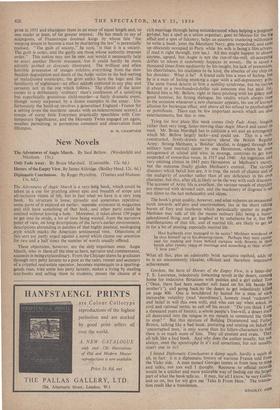Studies in Violence
THESE two books have little in common except the last word of their titles, but since the first is a factual record and the second an imagin- ative diagnosis they complement each other. Mr. Angle deals with v,arious outrages, accounting for some two hundred deaths amongst them; that occurred between 1870 and 1930 in Williamson County, Illinois, whose record in this respect is only surpassed by one other county in the entire Union. Taken in chronological order (not that the author does so) we have the Bloody Vendetta in the Seventies; a Phase of mining troubles lasting into the nineteen hundreds; the Herrin Massacre of 1922 (twenty-three dead, the worst single episode—mining again); and the Klan War of 1923-6, which over- laps a final phase of straight gang warfare. All this is soberly and competently covered and at first glance the effect is often pedestrian, The speech and the legal procedure, after all, are near enough English. and if the men and the acts are not, decades of gangster literature and films have made them seem so. (Notably the family-minded gangster. "Every time 1 kill a man it makes me sick afterwards. I guess it's my stomach," says Charlie Birger, who sternly forbade all gunplay in his home town for fear of compromising his children's education.) At second glance, however, some of the facts disclosed are staggering; among these Americans, mostly British by descent and Low Church by religion, we are on very strange ground indeed. Of the twenty strike-breakers killed, after surrender, on a single Morning, most were shot down while being driven through barbed Wire by their captors and several had their throats cut afterwards. "I'll see you in hell before you get any water," says a woman with a baby to a dying man, and presses her foot on his wounds. At the subsequent trial it takes a month to empanel a jury, and no one is convicted. Though it included no bloodshed on quite this scale, the Klan's assumption of absolute power in Herrin was hardly less remarkable. We find them gaoling half of the city authorities
(many of whom had with records anyway) and later sharing control of the streets with the National Guardsmen who had broken
facing an outside window." Throughout the book we hear seldom of truncheons, often of rifles and machine guns, sometimes of Private •armoured cars and once of abort;■,e aerial bombing. (The target, a sizeable bunker-like stronghold, eventually provides an anti-climax by being blown up with only four occupants.)
There is little by way of explanation. The flyleaf quotes "Socia- lism, Communism, and other doctrines have played no part. . . . The issues are strictly American, and the wrongs done are the native Products of the United States." The concluding page cites "lack of respect for law. Venal public servants. Union labour and 'free enterprise.' Black man and white man. Old-fashioned morality and lax standards of conduct. Protestant and Catholic. 'American' and foreigner." This tells. us nothing, except that liberty can breed its moronic savages as well as despotism. For after all the questions are raised and left unanswered, it is the impression of moronic savagery that remains. It was obviouslywidespread; many of the Worst atrocities were the work of ordinary ' citizens rather than professional killers or straight primitives from Sicily or Macedonia.
prize in 1951 and elucidates them in an essay of equal length and, to one reader at least, of far greater interest. He has much to say of scapegoats, of Frazeresque doomed kings by whose fate "the weeping dream to become a man by murdering the law" is perennially realised. "The guilt of society," he says, "is that it is a society. The guilt is order, and the guilty are those whose authority imposes order." This notion may not be new, nor would it necessarily help to avert another Herrin massacre, but it could hardly be more adroitly probed or diversely illustrated. The brilliant and often horrible procession of images exhibits everything from the slow fiendish degradation and death of the Aztec victim to the bed-wetting of maladjusted conscripts; the grim antics have the logic and the familiarity of nightmare—an effect seldom captured in any play and certainly not in the one which follows. The climax of the latter comes in a deliberately 'ordinary' man's confession of a satisfying but superficially gratuitous child-murder—a fairly dramatic event, though surely surpassed by a dozen examples in the essay. Un- fortunately the build-up involves a generalised England - France for a setting (even the murderer speaks with an indeterminate accent), a troupe of corny little Everymen practically speechless with Con- temporary Significance, and the Heavenly Twins engaged yet again, weather permitting, in portentous comment and observation from Olympus.
H. M. CHAMPNESS



































 Previous page
Previous page